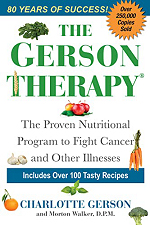| |
Archived from
Charlotte Gerson's book

Story
In
September 1985, pneumonia developed for forty-six-year-old Mrs. Ronald
(Patricia) Ainey of Nanaimo, British Columbia, Canada. Despite her being a
cigarette smoker and alcoholic beverage drinker, she had sustained good
general health throughout her life until that 1985 date. Then, in January
1986,
internist Bennett A. Horner, M.D., F.R.C.P(C), also of Nanaimo, using CAT
scan
guidance, had a biopsy performed (tissue drawn out with a fine needle)
from a
tumor site on Pat Ainey’s pancreas. The object of this scan and biopsy was
to
differentiate pancreatic cancer from several other conditions: benign
pancreatitis, pseudocyst, islet cell carcinoma, or lymphoma. Dr. Horner
confirmed the woman's diagnosis by letter to her family physician in the
same
town, A. C. Baird, M.B., CH.B, C.C.F.P Dr. Horner's letter stated: ‘Mrs.
Pat
Ainey returned to see me today, January 28, 1986. I informed her that she
does
have adenocarcinoma of the pancreas; there is no specific treatment
indicated
presently... if she has a lot of pain or discomfort, we’d be glad to help
her any
way we can.
Dr. Horner gave the patient and her husband Ron, who were one month
away from celebrating their thirtieth wedding anniversary, more personal
advice too. “The medical specialist told me, ‘Co home, get your life in
order, the
cancer is so bad it is inoperable,’ remembers Mrs. Ainey. “I went through
all
the anguish, the crying, and I finally resigned myself to my own death.”
She had learned that the malignancy had metastasized to her
gallbladder,
liver, and spleen. In just a few weeks she lost more than forty-five
pounds and
regularly vomited blood. She was classified as being in cytology class
(stage)
II—IV pancreatic cancer (which has a projected five-year survival of 1
percent
or less). There were no curative therapies and no proven adjuvant
treatment;
only palliation could be offered by orthodox oncologists to provide some
pain
control or ascites reduction. She did have ascites, jaundice, pleural
(chest wall)
effusion, alcoholic hepatitis, and pain. Any chemotherapy probably would
kill
Pat Ainey faster than the cancer itself.°
“When you're told by the medical profession that your days are
done, that’s
who you believe,” admits Mrs. Ainey. But then she read in the Nanaimo
Times
newspaper about a Victoria, B.C., man who had been cured of pancreatic
cancer
by engaging in the Gerson Therapy. “I decided I wasn’t going to just
bugger around crying and dying. I was going to try to live the last few
months as well as I could for myself and for my family.” While skeptical
at first, wondering if the Gerson hospital in Tijuana, Mexico, was a scam
designed to bilk desperate people, “It was the only hope I had. What I
needed was a miracle,” the woman says. “And my husband stomped his foot
down and said, ‘Dammit lady, pack your bag, we're catching the eleven
o'clock
boat to the mainland and going to Mexico to try this damn Gerson thing.” ”
Ron and Pat Ainey spent two weeks at the Gerson hospital in Playas,
a
suburb of Tijuana, where they learned to make her organic juices, what
kinds of
foods were appropriate, and how to self-administer five coffee enemas a
day.
She explains, “It wasn’t any fun, especially those ‘coffee breaks’ as we
called
them. But what choice did I have except to try?”
The Aineys had reserved two weeks to engage in the treatment, and
in ten
days she began to feel considerably better than she had in months. Knowing
that she would be required to live stringently on the Gerson program for a
minimum of two years, Mrs. Ainey took up the challenge to conduct the
Gerson therapy at home. And it worked well.
“In December 1986 my doctor told me he thought I had the cancer licked.”
A letter Dr. Baird wrote in February 1990 on another health matter states:
‘Mrs. Ainey was diagnosed as having a malignancy of her pancreas. She
received treatment of her disease outside of Canada, and I am pleased to
say
that as of the present time she has no evidence of recurrence of the
disease, and
what evidence of malignancy was present in 1985 has now gone.”
In a follow-up letter he wrote to an insurance company’s law firm
on that
other matter, Dr. Baird added: “In conclusion, I would like to comment
that
Mrs. Ainey has survived what is generally a fatal illness and now lives
life to
the full.”
We spoke with Patricia Ainey on November 20, 1999, at which time
she
acknowledged, “I feel good, excellent in fact. I’ve had these past fifteen
years to
live happily and well, which I was not supposed to have. I’ve watched my
grandchildren grow up and had a lot of good times in those years.” While
Mrs.
Ainey has been free of pancreatic cancer for all of this fifteen-year
period, she
still drinks lots of fresh, organic vegetable juices and takes a daily
coffee enema.
She also has regular blood tests and cancer markers taken, which she sends
to
the Gerson hospital for evaluation. Friends and family sometimes ask why
she
continues these practices if she is cured. Says husband Ron Ainey: “Pat
had been looking for a lifeline and once you've found one it’s very hard
to let go.”

|
|
